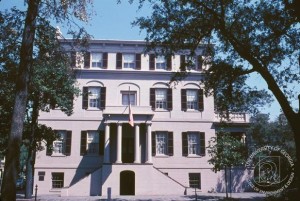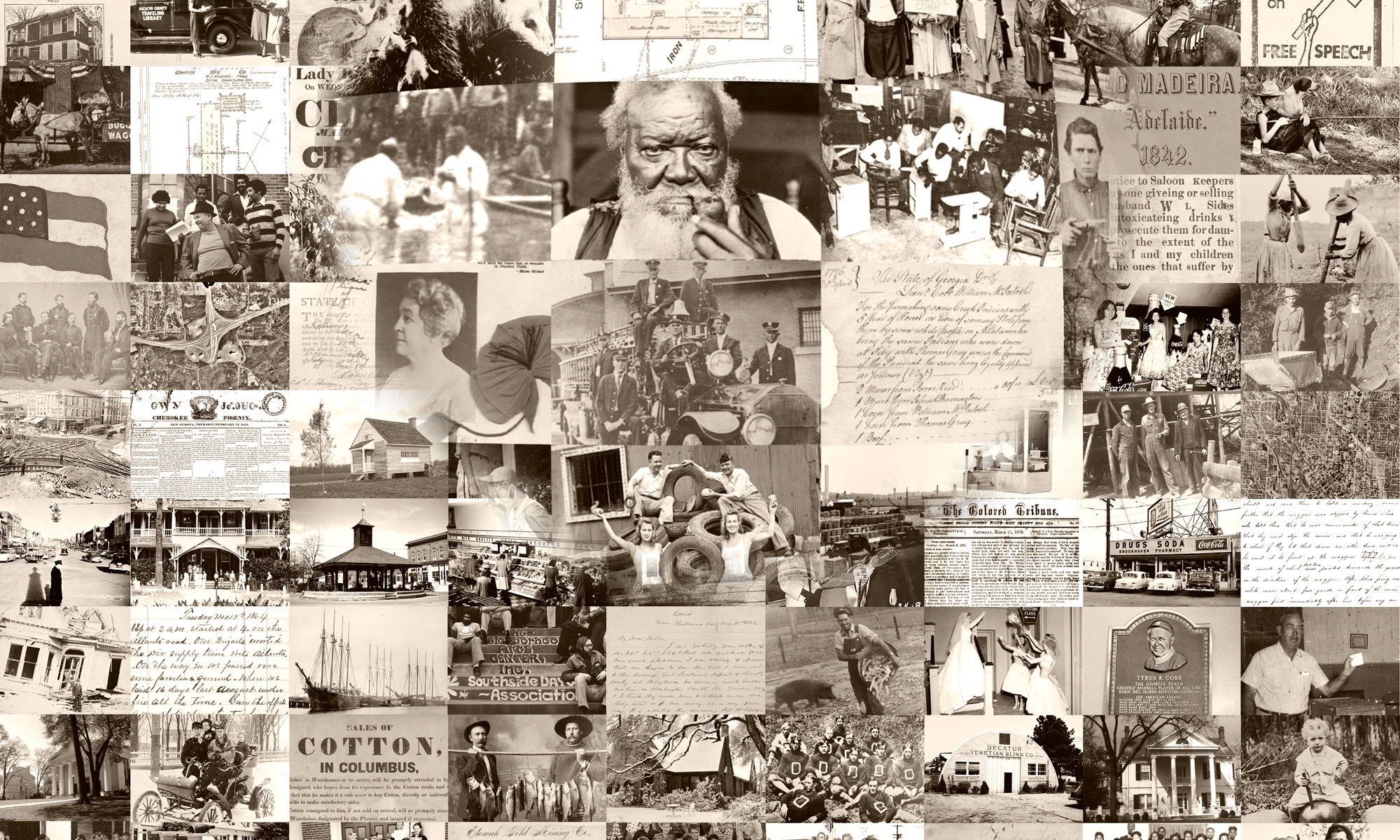If you plan on going for a drive to enjoy the fall foliage, why not take a look at some of these historic Georgia sites? From colonial forts and vibrant theaters to Savannah museums and prehistoric Indian mounds, chances are, with Georgia’s rich history, you can find a cultural resource that anyone in the family will enjoy. So buckle up and take a (virtual) road trip, starting with these sites.
 Kolomoki Mounds State Historic Park, located on a tributary of the Chattahoochee River in Early County, contains seven preserved prehistoric mounds that were occupied from 1000 BC to AD 900. The mounds were likely used for various ceremonial and mortuary rites by the indigenous Swift Creek and Weeden Island cultures. At the height of Kolomoki civilization, it was possibly among the most populous settlements north of Mexico. The mounds were excavated between 1894 and 1897, and again from 1948 to 1953. The results of these excavations, such as the kneeling ceramic figure (left), can be viewed by the public in a museum built on the park property. The museum’s exhibits present patrons with a history of the site, while also allowing them an interior view one of the mounds. More information about the Kolomoki mounds, as well as other Georgia state parks, can be found in the New Georgia Encyclopedia.
Kolomoki Mounds State Historic Park, located on a tributary of the Chattahoochee River in Early County, contains seven preserved prehistoric mounds that were occupied from 1000 BC to AD 900. The mounds were likely used for various ceremonial and mortuary rites by the indigenous Swift Creek and Weeden Island cultures. At the height of Kolomoki civilization, it was possibly among the most populous settlements north of Mexico. The mounds were excavated between 1894 and 1897, and again from 1948 to 1953. The results of these excavations, such as the kneeling ceramic figure (left), can be viewed by the public in a museum built on the park property. The museum’s exhibits present patrons with a history of the site, while also allowing them an interior view one of the mounds. More information about the Kolomoki mounds, as well as other Georgia state parks, can be found in the New Georgia Encyclopedia.
 Established by General James Oglethorpe in 1735, Fort Frederica is located on St. Simons Island. The site served as a British colonial military base; the star-shaped fort was strategically located on a high bluff, offering both protection and a superior view of the surrounding waterways. In 1742, the Spanish launched a siege to take possession of the fort after British forces failed to overpower Spanish possession of the city of St. Augustine during the War of Jenkins’ Ear. Despite being outnumbered, the British, led by Oglethorpe, forced a Spanish retreat after a two-week skirmish at Bloody Marsh. This was the last time the Spanish threatened English holdings in the area, and the British regiment disbanded in 1749. Nine years later, a fire reduced much of the fort to ashes; however, its ruins (pictured above) have been retained as the Fort Frederica National Monument, a reminder of the military struggles of the colonial era. More images of Fort Frederica can be viewed in the Vanishing Georgia collection.
Established by General James Oglethorpe in 1735, Fort Frederica is located on St. Simons Island. The site served as a British colonial military base; the star-shaped fort was strategically located on a high bluff, offering both protection and a superior view of the surrounding waterways. In 1742, the Spanish launched a siege to take possession of the fort after British forces failed to overpower Spanish possession of the city of St. Augustine during the War of Jenkins’ Ear. Despite being outnumbered, the British, led by Oglethorpe, forced a Spanish retreat after a two-week skirmish at Bloody Marsh. This was the last time the Spanish threatened English holdings in the area, and the British regiment disbanded in 1749. Nine years later, a fire reduced much of the fort to ashes; however, its ruins (pictured above) have been retained as the Fort Frederica National Monument, a reminder of the military struggles of the colonial era. More images of Fort Frederica can be viewed in the Vanishing Georgia collection.
 Listed on the National Register of Historic Places, the Springer Opera House in Columbus was built in 1871 by Alsatian immigrant Joseph Frances Springer, who wished to establish a European-style theater in the American south. The Springer Opera House quickly established a reputation for being one of the finest opera houses in the country. In its heyday, the theater boasted a diverse series of lectures and performances from renowned figures that included politicians William Jennings Bryan and Franklin D. Roosevelt, Shakespearean actor Edwin Booth, and Georgia blues singer Gertrude “Ma” Rainey. However, the theater fell into disuse after the stock market crash of 1929 and the subsequent decline of Columbus’ commercial district. Community support saved the Springer from demolition in 1964, and it reopened in 1965 after a series of renovations (see above image). Today, the expanded Springer Opera House serves as the official state theater of Georgia and is home to a thriving theater community. To view more images of the Springer Opera House, check out related items in the Vanishing Georgia collection. More information about the history of the theater and current showings can be located at the Springer Opera House website.
Listed on the National Register of Historic Places, the Springer Opera House in Columbus was built in 1871 by Alsatian immigrant Joseph Frances Springer, who wished to establish a European-style theater in the American south. The Springer Opera House quickly established a reputation for being one of the finest opera houses in the country. In its heyday, the theater boasted a diverse series of lectures and performances from renowned figures that included politicians William Jennings Bryan and Franklin D. Roosevelt, Shakespearean actor Edwin Booth, and Georgia blues singer Gertrude “Ma” Rainey. However, the theater fell into disuse after the stock market crash of 1929 and the subsequent decline of Columbus’ commercial district. Community support saved the Springer from demolition in 1964, and it reopened in 1965 after a series of renovations (see above image). Today, the expanded Springer Opera House serves as the official state theater of Georgia and is home to a thriving theater community. To view more images of the Springer Opera House, check out related items in the Vanishing Georgia collection. More information about the history of the theater and current showings can be located at the Springer Opera House website.
Originally constructed in 1818 by Savannah mayor James Wayne, this Federal-style “Savannah box” home was sold to the Gordon family in 1831; Juliette Gordon Low was born here in 1860. In 1911, Low met Sir Robert Baden-Powell, the founder of the worldwide Scouting movement; their meeting inspired her to become involved with the Girl Guides of Great Britain. Recognizing the need for a similar organization for American girls, Low returned to Georgia and founded the Girl Scouts of the United States of America; the first registered members were located in Savannah. She dedicated the rest of her life to scouting. In 1925, two years before her death, there were over ninety thousand Girl Scouts active in America.  Today, the Wayne-Gordon house (see image on right), is a museum dedicated to the history of the Girl Scouts and the memory of their founder; the home has become a congregating point for modern-day Girl Scouts all across America. More images of the Wayne-Gordon House can be found in the digital collection Historic Architecture and Landscapes of Georgia: The Hubert Bond Owens and John Linley Image Collections at the Owens Library. Further information about the house’s history and tours can be found at the Juliette Gordon Low Birthplace website.
Today, the Wayne-Gordon house (see image on right), is a museum dedicated to the history of the Girl Scouts and the memory of their founder; the home has become a congregating point for modern-day Girl Scouts all across America. More images of the Wayne-Gordon House can be found in the digital collection Historic Architecture and Landscapes of Georgia: The Hubert Bond Owens and John Linley Image Collections at the Owens Library. Further information about the house’s history and tours can be found at the Juliette Gordon Low Birthplace website.
These sites are just a few of Georgia’s historic gems, why not hit the road this fall and discover them?














